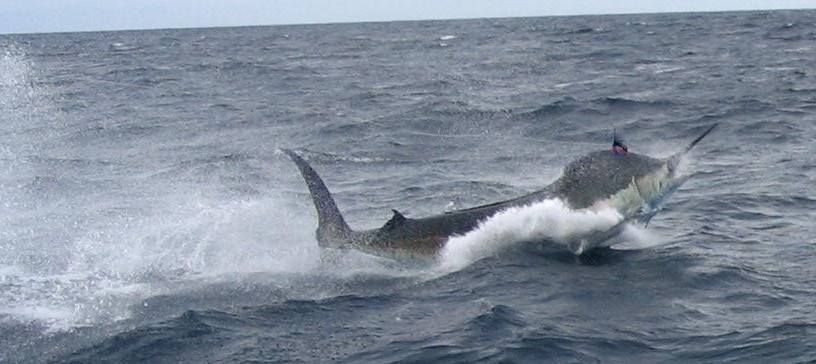
Atlantic Hot Spots
by Jim Chambers
December 2008
Those who hunt for big fish in the Atlantic Ocean, such as swordfish, blue marlin and bluefin tuna, would like to know where they are likely to occur during each season of the year. We plan our long range fishing trips accordingly.
The fish we seek are not randomly dispersed over the entire ocean but concentrate (where their prey concentrates) in a series of relatively small areas as the adults follow the major surface currents in a large annual circle around both the North and South Atlantic Oceans. Surprisingly, swordfish, blue marlin and white marlin all use many of the same areas at the same times. Here they can be targeted for specific periods of time particularly on their spawning grounds (in late spring) and on their feeding grounds (summer through fall).
The information I will share with you is, unfortunately, probably well known to the commercial fishing fleets numbering tens of thousands of very large vessels from about 50 nations that fish the Atlantic Ocean (some legally and some illegally) following swordfish and the larger tunas (bluefin, bigeye and yellowfin) throughout their annual migration every day of the year. According to scientific teams led by Drs. Ransom Myers (now deceased) and Boris Worm of Dalhousie University, Halifax, Nova Scotia, in just the last 50 years, commercial exploitation has removed about 90% of the big fish biomass of the world ocean. The North Atlantic has been particularly hard hit.
The big game fishing community recognizes the importance of releasing these magnificent fish alive, especially the largest ones, and it has done so voluntarily for years. All blue marlin over 350 lbs and all swordfish over about 150 lbs are probably females. Blue marlin and swordfish females may reach a maximum of perhaps 3,000 lbs while bluefin could reach 2,000 lbs. The largest individuals produce the most eggs and their young survive better. Big females are key to the future of big game fishing and should be protected.
For the past decade, as a biologist and big game fisherman, I’ve become deeply interested in big fish – marlin, swordfish and tuna – because of their serious population declines (very well documented for the Atlantic) and a need to understand their life cycle (where do they spawn and migrate?) so that they can be protected in their critical habitats. For the last three years of my 30 year federal career, I was involved in developing fishery management plans for Atlantic swordfish, blue marlin, white marlin and bluefin tuna. In the process I learned a lot about the fish including how, when and where they were caught.
Longlines
The primary gear responsible for the decline of both marlin species is the longline. It can be 40 to 80 miles long, with baited hooks about 100 yds apart fished all night about 150 ft below the surface. It is set to catch the “money fish” - swordfish and large tuna - but it catches and kills marlin and anything with a mouth wider than 2 inches and even those species which accidentally become foul-hooked as they swim past.
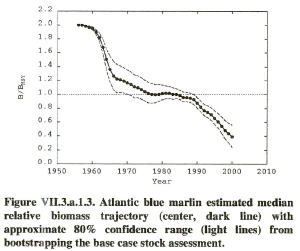 |
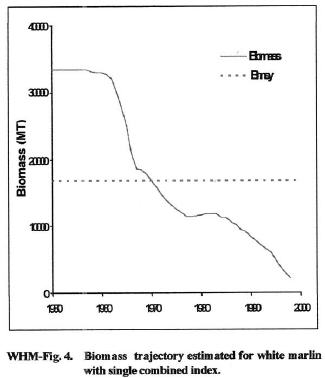 |
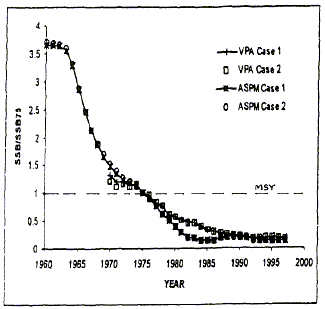 |
Since longlining began about 1960, Atlantic blue marlin (left) have been allowed to decline in abundance by about 80%, Atlantic white marlin (center) by 94% and western North Atlantic bluefin tuna (right) by more than 97%, as shown above. The horizontal dashed line marks the Maximum Sustainable Yield level. Responsible fishery managers would never allow a population to slip below this level. For the details, see the Extinction page of my website: www.BigMarineFish.com/extinction.html
Because of the severity of the decline of Atlantic white marlin and its trajectory, I authored a detailed petition (www.BigMarineFish.com/white_marlin_ESA_listing_petition_pg1.html), with my attorney colleagues in the Biodiversity Legal Foundation, to have white marlin “listed” and then protected under the Endangered Species Act. After 2 years of “evaluation” by a hand-picked group of state and federal employees, the Bush administration decided it would take no action until the population reached 1% of its “unfished” 1960 abundance. A petition has also been developed by the Center for Biological Diversity to have bluefin tuna “listed” and then protected as well (see http://www.biologicaldiversity.org/species/fish/Atlantic_bluefin_tuna/pdfs/BluefinTunaPetition-5-24-2010.pdf). I believe it should call for closure of the spawning grounds to longlines, a 5-year moratorium on all lethal fishing and better protection of their primary prey (e.g., herring, menhaden and squid).
Swordfish
For my understanding of where billfish migrate and why, the most insightful source of information has been a Ph. D. dissertation by Fred Arocha of Venezuela for the University of Miami on the life history of North Atlantic swordfish. It is based on extensive sampling aboard longliners fishing the western North Atlantic. He identified the following for the entire North Atlantic: (1) where and when the adults concentrate to spawn (during May in the gaps between the larger Caribbean islands and two areas about 350 and 550 miles east of the Caribbean chain of islands); (2) the general location of their nursery areas (down-current from their spawning sites in the Caribbean Sea, the northern Gulf of Mexico and Florida’s east coast) where the juveniles remain for their first two to three years; and (3) where the adults migrate to feed during the remainder of the year (following the major surface currents - the Gulf Stream which flows northward along the U.S. continental shelf then northeast toward the Azores) eventually circling the North Atlantic in a clockwise direction bringing them back again to their spawning areas by late spring. This is depicted in his chart reproduced on my website: www.BigMarineFish.com/swordlife.html
Marlin and Sailfish, Too
Eventually, I came to realize that blue marlin, white marlin and to a lesser degree sailfish follow exactly the same annual spawning and migratory pattern. I based this primarily on charts developed by my colleague, Dr. Pamela Mace then also with the National Marine Fisheries Service, from U.S. longliners’ mandatory reports to the federal government identifying the location and catch composition of every longline set. Since almost every part of the western North Atlantic was “sampled” by the longliners each year, we have an excellent method of determining where each species was concentrated at each season of the year. I used those data which were reported from 1992 through 1995. After this, the longliners’ reporting of billfish catch declined dramatically; international stock assessments were showing serious declines in marlin and swordfish populations and the longliners’ wanted none of their logbook reports to support this for fear of limitations on their future activities.
Hot Spots
I think of these areas of concentration as “hot spots.” They are depicted for the western North Atlantic in a series of charts (by quarter for 1994 and 1995) here:
blue marlin (in 1994): http://www.BigMarineFish.com/bmarlin94.html
white marlin (in 1994): http://www.BigMarineFish.com/wmarlin94.html and
sailfish (in 1994): http://www.BigMarineFish.com/sail94.html
Each year, during May and the first week of June (the second quarter in the charts identified above), adult blue marlin, white marlin, sailfish and swordfish concentrate to spawn at about 12 Caribbean area locations, which glow red in the charts listed above. I believe that the adults return year-after-year to the same spawning sites where they began life, just as salmon return to their exact stream of origin. For the western North Atlantic, these spawning area “hot spots“ are located in the deepwater gaps between the largest of the Caribbean islands (i.e., the Yucatan Straits between Mexico and Cuba, the Florida Straits between Cuba and Florida for swordfish, the Windward Passage between Cuba and Haiti, the Mona Passage between the Dominican Republic and Puerto Rico, the gap between Puerto Rico and the Virgin Islands, the Anegada Passage between the Virgin Islands and St. Maarten), and two large areas, one about 550 miles east of St. Maarten and the other, 350 miles east of Trinidad. The latter two spawning sites appear to be the most important. They are positioned on or near the two major surface currents, the North Equatorial and the South Equatorial (see chart below), which flow from West Africa toward the Caribbean. North Atlantic hurricanes originating over West Africa track westward along and are powered by the northern of these two warm water currents.
While the billfish all spawn at the same location at the same time, swordfish spawn at greater depth than do the others. Since all their young eat anything they can catch including other young billfish, such a separation by depth has distinct survival advantages.
Additional evidence of the timing and location of marlin spawning is provided in published scientific studies. Marlin ovary maturation peaks in May and larval blue and white marlin have been collected in plankton nets in Exuma Sound (in the Bahamas) and the Mona Passage. If you want to see what a half inch blue marlin looks like, go here: www.BigMarineFish.com/photos_blue_marlin_pg5.html
Over the years, I have paid close attention to published reports in both the Atlantic and Pacific Oceans by the sport fishing community on where and when marlin (blue, white, black and striped), sailfish, swordfish, bluefin, bigeye and yellowfin tuna were caught, especially where fish large enough to be considered adults were caught during the period when they ought to be spawning. The location and timing of IGFA all tackle world record catches is also very instructive. Based on recently reported catches by sport fishermen, I think there is a very good chance that spawning also occurs during May and early June on the eastern side of the North Atlantic at about the same latitude as the Caribbean (15 to 20 degrees N.), the area of the Cape Verdes Islands (e.g., see Capt. Les Gallagher’s article in Marlin, December/January 2008).
Why do marlin and swordfish spawn in these locations? Probably to position their young where they will have the best chance of survival – sufficient food, moderate temperatures and fewer predators. Over thousands of years of their evolution, those adults that chose these areas to spawn were more successful in terms of the young’s survival than those which spawned elsewhere – survival of the fittest in action. As you would expect, their nursery areas are located down-current from the spawning sites. Major nursery areas include the coast of Venezuela (down-current from the spawning site on the South Equatorial Current), the northern Caribbean Sea (down-current from all the gaps between the Caribbean islands), the northern Gulf of Mexico (down-current from the Yucatan Straits spawning site), and the east coast of Florida (down-current from the spawning site in the Florida Straits between Florida and Cuba). Since longlining is prohibited in the Bahamas and Cuban waters, we have no data from U.S. longliners from these areas. If we did, I would expect we would find spawning areas and nursery grounds in both. Juvenile marlin and swordfish remain in their general nursery areas, perhaps venturing further and further north along the U.S. East Coast as they grow larger, until they become adults capable of spawning. As adults, the migratory pattern of both marlins and swordfish expands considerably.
Creatures of the Edge
The second most important thing I learned about where to find big billfish came from the longliners’ chief lobbyist, Nelson Beideman, who was, until his death, Executive Director of the Bluewater Fishermen’s Association. He explained that swords and marlin concentrate at the edges (both western and eastern edges) of the major surface currents particularly the Gulf Stream. He said a longline set 3 feet on the “right” side of the edge could be loaded with swords (and other big fish) whereas a set 3 feet on the “wrong” side could produce nothing. Placing a longline with this accuracy at an edge 150 ft down, which might be a quarter mile away from the same edge at the surface, is a real skill. The big fish are here to find prey, which must also be concentrated on the “right” side of the edge. The best edge to locate for its concentration of big fish (and their prey) is the leading edge of a warm core eddy as it breaks off of a major current such as the Gulf Stream. Off the east coast of the U.S., these warm core eddies or gyres, sweep back in a southwestern direction into and over the continental shelf. They are large (over 100 miles across) and can be long lived (lasting more than a month). The best situation is when the leading edge moves against the wall of a submarine canyon such as the Hudson. These events are clearly visible in sea surface temperature charts commercially available. Such satellite charts showing chlorophyll concentrations are also useful in showing algal biomass concentrations - on which the marine food web is based. Once the general location of an edge is found on the water, signs of “life” (diving birds, whales, schools of baitfish especially breaking the surface, etc.) become the important key to locating big fish. Find prey and the big ones are nearby.

The big picture of the annual migration of adult swordfish, blue marlin and white marlin in the North Atlantic may really be a picture of its major surface currents, shown above. Spawning occurs in the Caribbean from about 1 May through the first week in June (it takes about that long for all of a big females’ eggs to mature and be released in batches every few days). As soon as spawning is complete, the adults of all three species migrate along the edges of the major surface currents fairly quickly to northern waters which have much larger volumes of available prey. The clear water of the tropics indicates it has less plant and animal plankton than do colder, more nutrient-rich waters toward the poles. In the tropics, there are greater numbers of different species, whereas northern waters have fewer species but much greater abundance. Big fish like these need frequent, large meals to fuel their high metabolism and, for a female blue marlin, swordfish or bluefin, to provide enough energy to produce up to 20 million eggs. Soon after spawning, most of the adult billfish from the Caribbean spawning areas follow the edge of the continental shelf along the U.S. east coast and out to the tip of Georges Bank. (Another group of marlin appears to follow the Loop Current only to the northern Gulf of Mexico.) From late June through August, white marlin, and to a lesser extent blue marlin and swordfish, concentrate along the edge of the continental shelf between Cape Hatteras and the tip of Georges Bank. Tournaments such as the White Marlin Open, take advantage of this feeding area “hot spot.” Some adult marlin and swordfish also must follow the Gulf Stream past Bermuda on their way to their primary feeding grounds at the northern part of their range. From late summer through fall they are predominantly found in the broad area between the Grand Banks and the Azores (at about 40 degrees N. Latitude) following the Gulf Stream and its extension, the Azores Current. (The movie “The Perfect Storm” took place in the center of this area.) They do not abandon this their richest feeding grounds until winter drives them slowly south - either back along the Gulf Stream or clockwise following the Azores Current toward Madeira and the Canary Current towards the Canary Islands off northwest Africa. By May, I believe many of these have followed the North Equatorial Current back across the Atlantic to their Caribbean spawning area “hot spots.” As noted above, some may be returning to a possible Cape Verdes spawning area off west Africa.
Sailfish
Of all the big fish, we know the least about sailfish - both their population status and their migratory strategies. I believe they are not highly migratory. They use the same Caribbean spawning areas as do marlin and swordfish (based on longliners’ reported catches) but must have others as well which are not “sampled” by the longliners. They appear to remain very close to their spawning areas and stay well inshore. I expect we will find there are a number of discrete sailfish populations scattered along the coast in the tropics, with little or no intermixing, located near their spawning sites. For example, the population that spawns in the Florida Straits (in May-June), apparently migrates only up the west and east coast of Florida.
Bluefin Tuna
The bluefin, my favorite of all, follows a different drummer. In the Atlantic, there are two separate populations which spawn at the same time each year but half a world apart. They do not interbreed. One spawns in the Mediterranean Sea (primarily between Italy, Sicily and Sardinia). “Ours” spawns in the north central Gulf of Mexico (also May through early June) generally beyond the edge of the continental shelf (and thus out of range of most sport fishers). Here they are vulnerable to longlines supposedly targeting yellowfin. I am sure that bluefin once spawned in the Bahamas, but this sub-population appears to have been wiped out by overfishing throughout its northern range since 1960.
Bluefin mature at 12 years old and a weight of about 620 lbs. Once the adults complete spawning, they pass rapidly around south Florida and up the East Coast (generally following the 30 fathom depth contour) to their summer-through-fall feeding grounds off New England (e.g., Cape Cod, Stellwagen Bank and Jeffry’s Ledge) and around Nova Scotia. However, midwater pair-trawling for herring in the Gulf of Maine has been removing their primary food source and probably forcing the giants out to the mid-Atlantic with the adult swordfish and marlin and toward the Azores and beyond following the major surface currents described above. Adults of Mediterranean origin mix in this rich feeding area. “Our” juveniles’ nursery grounds are located over the continental shelf off the mid-Atlantic states, occasionally extending northward (associated with rising ocean temperatures due to global warming) into the Gulf of Maine. But with the onset of winter, they are pushed by the cold Labrador Current down to the area just below Cape Hatteras (which is warmed by the Gulf Stream). This has quickly grown into a superb winter fishery (December through February).
South Atlantic Ocean
The annual migratory pattern of the South Atlantic’s big fish appears to be a mirror image of the North Atlantic, but the currents rotate in the opposite direction (counter clockwise due to the Earth’s rotation). In addition, the timing of the cycle is six months later than in the northern hemisphere. Here, spawning of the big fish also occurs in late spring - November and early December. A number of all-tackle and line class world record catches have occurred then in what I believe is the primary South Atlantic spawning area - located at the Royal Charlotte Bank, a large submerged plateau, much like Georges Bank, extending off Vittoria, Brazil, which is located a little north of Rio de Janeiro. It is the Brazil Current that bathes this spawning area and flows south along the coast. It is fed by the South Equatorial Current flowing westward across the South Atlantic from Africa and it is fed by the Benguela Current which flows up the coast from South Africa. I suspect that once spawning is completed, the adults follow the Brazil Current down the coast of South America and out into their rich feeding grounds in middle of the South Atlantic (about 40 degrees S. Latitude) until the southern winter (our summer) drives them north back slowly towards the Equator along the west coast of South Africa. Here they follow the Benguela Current which takes them past Ghana (a new blue marlin fishing “hot spot”) then west across the South Atlantic following the South Equatorial Current past Ascension Island (another new blue marlin fishing “hot spot”) ultimately towards their primary spawning site off Brazil. I would expect the primary nursery area of South Atlantic blue marlin, white marlin and swordfish to be located down-current from the Royal Charlotte Bank, i.e., along the coast of Brazil. Because of the distance between the primary spawning areas of the North and South Atlantic and the fact that they are used six months apart, I have no doubt that their blue marlin, white marlin and swordfish populations do not interbreed with “ours” of the North Atlantic described above.
One may wonder, “What about bluefin tuna? Why are there none in the South Atlantic?" They probably did spawn in the same general area off Brazil as do blue marlin, swordfish and white marlin. But bluefin were wiped out by longliners in just 10 years between 1960 and 1970, as depicted in the latest stock assessment report for bluefin tuna as published by ICCAT (see Figure 1 on page 14 of http://www.iccat.int/Documents/SCRS/ExecSum/BFT_EN.pdf). No bluefin tuna have been caught in the South Atlantic Ocean in the last 40 years. ICCAT, the International Commission for the Conservation of Atlantic Tunas is the international body which has claimed management authority over fishing for tuna and tuna-like fishes of the Atlantic. It has done a magnificent job of documenting the near total destruction of bluefin, blue marlin, white marlin and probably most shark species which it is supposed to be conserving at their maximum sustainable yield levels. Swordfish are also still in trouble but ICCAT's swordfish stock assessment committee has been covering this up (see www.BigMarineFish.swordfish.html).
Pacific Ocean
I would speculate that in the Pacific, we should find the same general pattern of spawning areas and migratory patterns holds true: two circular migratory paths by the adults following the major surface currents rotating clockwise above the Equator and counterclockwise below it with spawning occurring in the spring in each hemisphere (May-June in the northern and November-December in the southern). For example, the Great Barrier Reef is probably a major spawning site during November and December for black marlin, blue marlin and perhaps striped marlin. The coast of Peru and Chile that produced the still standing all-tackle world records in the 1950s for Howard Glassell (black marlin), George Garey and Lou Marron (swordfish), as well as granders for Ted Williams and authors Zane Grey and Kip Farrington among others, was a primary summer-fall feeding ground until the anchovy, upon which their tuna prey depended, was wiped out by excessive commercial exploitation.
Where and When To Go?
North Atlantic blue marlin, white marlin and swordfish could be targeted at their spawning area “hot spots” in the Caribbean region (and the Cape Verdes) from May 1 through early June. They can be followed along the Loop Current to the northern Gulf of Mexico and the Gulf Stream up the U.S. East Coast (and to Bermuda) through June and early July. During this period, white marlin, in particular, can be found concentrated along the 100 fathom edge of the continental shelf from Cape Hatteras to the tip of Georges Bank. From August through October, adult blue and white marlin and swordfish should be spread across the area between the Grand Banks and the Azores. The latter are a group of nine volcanic islands lying directly in the path of the southern prong of the Gulf Stream, which I believe acts as a giant “conveyor belt” bringing large numbers of very large blue marlin, white marlin, swordfish, bluefin tuna, bigeye tuna and many species of sharks to “structure” causing major upwellings of nutrient-rich bottom waters (producing an explosion of plankton on which the marine food web depends) as well as easy access by sport fishers. In my opinion, this is the place where one has the best chance to catch the very largest blue marlin. (See my article “Grander Hunting” reproduced at www.BigMarineFish.com/grander_hunting.html) By late October and early November, many of the big fish should be moving south toward warmer waters, either circling back along the Gulf Stream or following the Azores current southeast passing by Madeira, then the Canary and Cape Verde Islands off Africa. If one is interested in catching juvenile billfish, the waters off Venezuela’s La Guaira Bank provide a year-round nursery ground. Other major nursery grounds include the northwest coast of Florida (the area of the De Soto Canyon), the southeast coast of Florida and the areas inside the Caribbean Sea down-current from the major gaps between the largest islands in the chain.
Notwithstanding the above, for those Atlantic species now facing a real danger of extinction (particularly bluefin tuna, white marlin and to a lesser degree, blue marlin), I think we should refrain from targeting the big females in their spawning area “hot spots” until they can recover. And since white marlin are particularly vulnerable when on their summer feeding ground (their last refuge?) where they concentrate in a narrow band along the edge of the continental shelf off our mid-Atlantic coast, sport fishermen should continue to minimize the mortality caused by tournaments. For “our” bluefin which have declined by about 97%, all lethal fishing targeting them in both their spawning area and their feeding grounds should be suspended. It is not good for any of these threatened fish to be fighting for their lives (with some inevitable mortality) and using up precious energy, especially while they are in the process of creating the next generation. The same applies to the Great Barrier Reef black marlin fishery.
|
Chambers and Associates 9814 Kensington Parkway Kensington, Maryland 20895 (T) 301-949-7778 (Fax) 301-949-3003 |
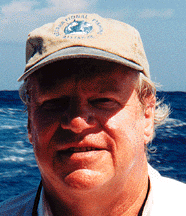
Jim Chambers